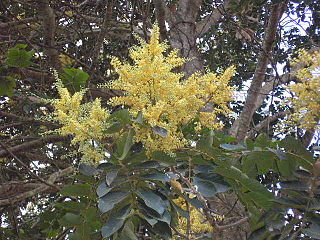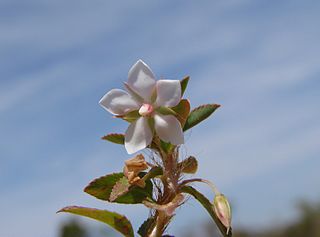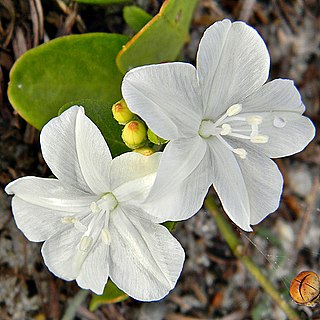
Boraginaceae, the borage or forget-me-notfamily, includes about 2,000 species of shrubs, trees, and herbs in 146 to 154 genera with a worldwide distribution.

Dovyalis is a genus of shrubs and small trees. Recent genetic evidence has shown the genus to belong to the family Salicaceae; formerly it was classified in the family Flacourtiaceae. The 15 species are native to Africa and southern Asia. Some are cultivated for their fruit.

Ormosia is a genus of legumes. 131 living species, mostly trees or large shrubs, are native to the tropical Americas, from southwestern Mexico to Bolivia and southern Brazil, to southern, southeastern, and eastern Asia, and to New Guinea and Queensland. Most are tropical, while some extend into temperate temperate regions of China. A few species are threatened by habitat destruction, while the Hainan ormosia is probably extinct already.

Tachigali is a flowering plant genus in the legume family (Fabaceae). It includes 74 species of trees native to the tropical Americas, ranging from Nicaragua to Bolivia, Paraguay, and southern Brazil. Typical habitats include tropical rain forest, lower montane forest, seasonally-flooded and non-flooded evergreen lowland forest and woodland, gallery and riparian forest, sometimes on white sands, cerrado and other dry woodland, and rocky grassland.

Bonamia is a genus of the flowering plant family Convolvulaceae, commonly known as the bindweed family and named after the French physician and botanist François Bonamy (1710-1786). Members of the genus are commonly known as the lady's nightcap.

Sauvagesia is a genus of plants in the family Ochnaceae. It includes 49 species native to the tropical Americas, tropical Africa, and Madagascar.

Cyrtopodium, often abbreviated Cyrt in horticulture, is a genus of more than 40 species of epiphytic and terrestrial orchids found from Florida and Mexico through Argentina. Cyrtopodium is the only genus in the monotypic subtribe Cyrtopodiinae.

Harpalyce is a genus of flowering plants in the family Fabaceae. It belongs to the subfamily Faboideae. It includes 35 species of shrubs and small trees native to the tropical Americas. Their distribution is disjunct, ranging from Mexico to Nicaragua, Cuba, and northern to southeastern Brazil and Bolivia. Typical habitats include seasonally-dry tropical forest, warm-temperate humid forest, woodland, bushland and thicket, shrubland, and grassland. Most species are evergreen and flower during the dry season.

Hypocalyptus is a genus of flowering plants in the family Fabaceae. It includes three species of shrubs, subshrubs or small trees native to the Cape region of South Africa. Typical habitats include Mediterranean-climate shrubland (fynbos) at forest margins, in rocky and sandy areas, and along streams, often at high elevations.

Luetzelburgia is a genus of flowering plants in the legume family, Fabaceae. It includes 14 species of trees and shrubs native to Brazil, Bolivia, and Colombia. Typical habitat is seasonally-dry tropical lowland woodland and wooded grassland, and occasionally lowland rain forests. The genus belongs to the subfamily Faboideae. It was traditionally assigned to the tribe Sophoreae, mainly on the basis of flower morphology; recent molecular phylogenetic analyses assigned Luetzelburgia into an informal, monophyletic clade called the "vataireoids". Keys for the different species of Luetzelburgia have been published.

The vataireoids are an early-branching monophyletic clade of the flowering plant subfamily Faboideae that are mostly found in northern South America, primarily Brazil.
Staminodianthus is a genus of trees found in South America. It includes three species of trees, from small trees to six meters tall to large trees up to 40 m tall. They are native to the Amazon Basin of northern Brazil, Colombia, Guyana, Peru, and Venezuela, where they grow in humid non-flooded terra-firme forests on sandy or sandy loam soils, gallery forests, and highland savannas.

Jacquemontia is a genus of plants in the morning glory family Convolvulaceae. Species in this genus are commonly known as clustervine.
Ctenodon is a genus of flowering plants in the pea family (Fabaceae). It includes 64 species which range from the southern United States through Mexico, Central America, the Caribbean Islands, and northern South America as far as northeastern Argentina.
The Development Bank of Sarawak Berhad (DBOS) was incorporated on 11 May 2017 as a public company limited by shares. DBOS is to carry on business as a Development Financial Institution and lending activities with sources of funding from capital injections from DBOS’ holding company, Sarawak Government’s deposits and deposits from Sarawak Government’s statutory bodies and linked companies. Its role is to support the Sarawak Government’s efforts in the development of strategic infrastructure projects.
Ctenodon elegans is a species of flowering plants in the family Fabaceae. It is endemic to eastern and west-central Brazil.
Sasoma–Sasser La-Saser Brangsa-Gapsam-Daulat Beg Oldi Road 131 km long road through 17,800 feet (5,400 m) high Saser La, and its 18-km-long northwest-to-southeast fork the Sasser Brangsa-Murgo Road, are 30-ft-wide black-topped heavy-military-vehicle-grade motorable road between Nubra Valley and Depsang Plains in Ladakh in India. The sections of SSSG-DBO Road are the 47 km long "Sasoma - Saser La section", 27 km long "Saser La-Saser Brangsa section", 42 km long "Saser Brangsa-Gapsam section" along the upstream of Shyok River which goes northeast of Saser Brangsa, and 10 km long "Gapsam-DBO section". Just after the Saser Brangsa, after crossing the 345 m long bridge over the Shyok River, the SSSG-DBO Road forks into two: 18 km long "Saser Brangsa-Murgo Road" along the downstream of Shyok River which goes southeast of Saser Brangsa, and 52 km long Saser Brangsa-Gapsam-DBO route along the upstream of Shyok River which goes northeast of Saser Brangsa. These forks connect to the Darbuk–Shyok–DBO Road at two places: at Daulat Beg Oldi in northeast and at Murgo in southeast. This strategically important road provides a much shorter alternative access from Nubra Valley to DBO as compared to the longer 230 km route via "DS-DBO Road", reducing the travel time between Nubra valley and DBO from 2 days to mere 6 hours. In September 2023, several sections of the road are already complete, the whole blacktopped route will be completed by October 2024. To provide the all-weather connectivity, the DPR for 7 km long Saser La tunnel under the Saser La till Saser Brangsa was being prepared in June 2023, the tunnel construction will commence in 2025 and will be completed by 2028.

Acanthocladus is a genus of flowering plants in the family Polygalaceae. Species of the genus are native to South America.
Shyok or Shayok is a village on the bank of the Shyok River in Durbuk tehsil of Leh district in Ladakh, India. It is located at the southern tip of the V-shaped course of the Shyok River, where the Tangtse river joins it from the left. Historically, the winter caravan route from Leh to Yarkand passed through the village. In modern times, India's strategic road to its border post at Daulat Beg Oldi uses the same route.

Distimake is a genus of flowering plants belonging to the family Convolvulaceae.













